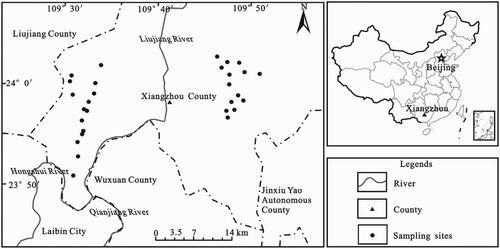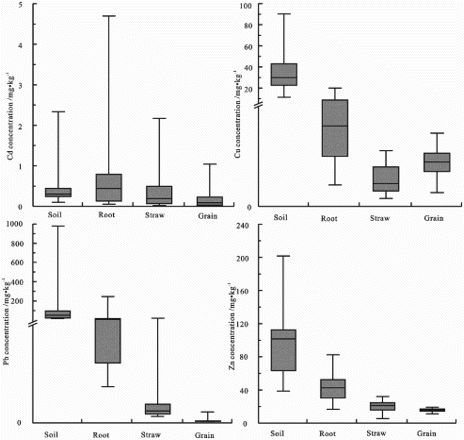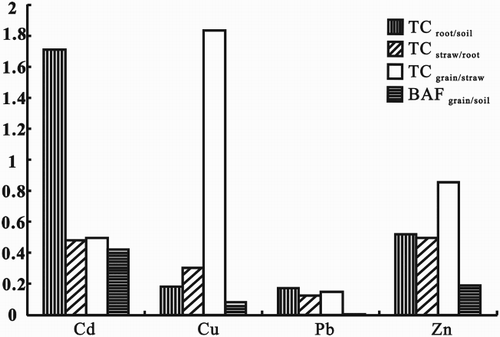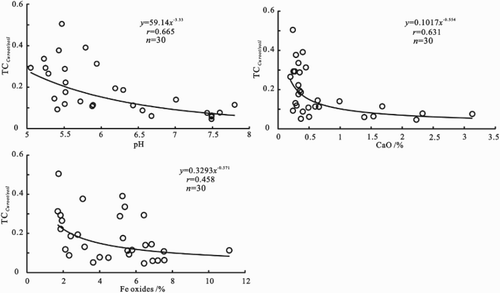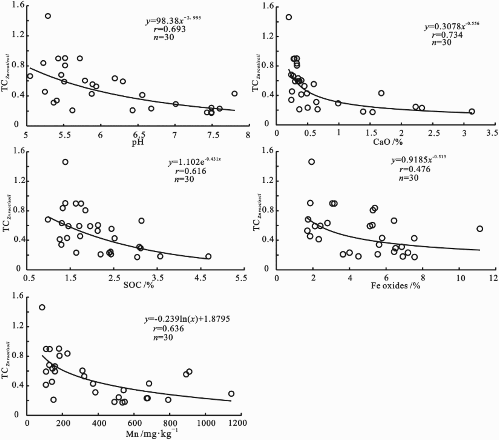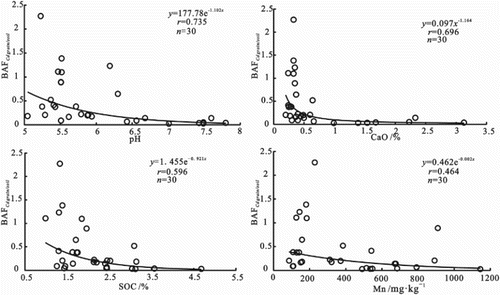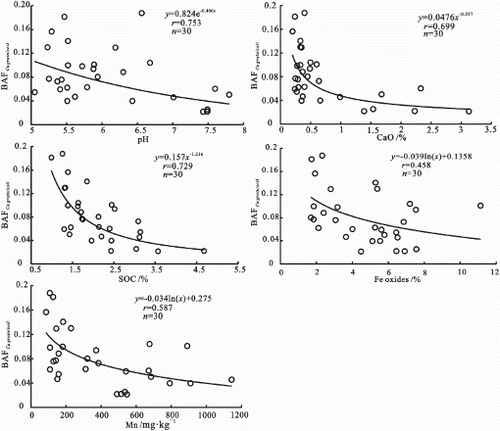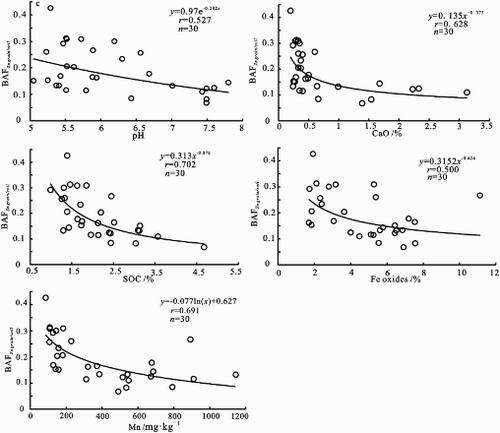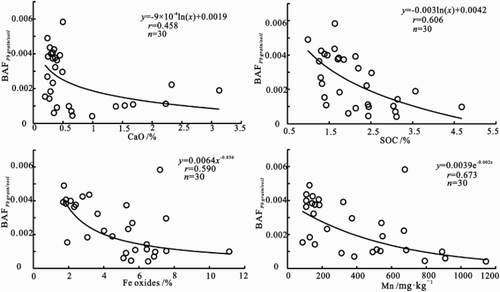ABSTRACT
For the purpose of studying the contamination, bioaccumulation and transfer of heavy metals and understanding the effects of soil properties on these, the work was carried out on a regional scale. A total of 30 sets of soil and pairing rice tissues samples (root, straw and grain) were collected in Xiangzhou of Guangxi, China; soil properties and Cd, Cu, Pb and Zn of different rice tissues were analyzed. The mobility and bioaccumulation of Cd, Cu, Pb and Zn were assessed by transfer coefficients and bioaccumulation factors of them. The results indicated that the excess proportions of Cd and Pb were 50%, 3.33% and 30%, 6.67% in soil and rice grain, respectively, according to Chinese maximum permitted concentrations of heavy metals. Cd and Zn showed stronger bioaccumulation and mobility capability; the bioaccumulation and transfer of Cu were slightly lower than Cd and Zn; Pb had the weakest mobility. The bioaccumulation and mobility of heavy metals from soil to rice were restrained by soil pH, CaO, SOC, Fe oxides and Mn.
Introduction
Rice is one of the main crops in Xiangzhou, Guangxi known as granary in Guizhong Areas. The transfer and bioaccumulation of heavy metals from soil to rice are of great importance to human health, and rice cultivated in the pollution or high geological background of paddy soil can cause potential health problems (Wang et al. Citation2013; Kwon et al. Citation2017). Hence, heavy metals transfer and bioaccumulation in soil-rice system have become a hot topic.
With the development of urbanisation, industrialisation and the population growth, soil heavy metal pollution has caught worldwide attention in the last few decades due to its non- biodegradability and persistence in soils, which may cause environment pollution and human health problem (Sollitto et al. Citation2010; Luo et al. Citation2012; Gu et al. Citation2014; Zou et al. Citation2015; Kwon et al. Citation2017).
Heavy metals, one of the most primary types of contaminants, can be found in the tissues of plants, such as root, straw and grain (Zhao et al. Citation2010). Heavy metals uptake by plants roots and their transfer in soil-rice system were dominated by pH, cation exchange capacity, organic matter, plant species, and crop management practices (Cooper et al. Citation2011; Rodda et al. Citation2011; Zeng et al. Citation2011).
Consequently, the objectives of the present work are, (1) to examine Cadmium (Cd), Copper (Cu), Lead (Pb) and Zinc (Zn) concentrations of various rice tissues (root, straw and grain); (2) to evaluate the total metal bioaccumulation capacities of rice; (3) to discuss effects of soil pH, Soil Organic Carbon (SOC), CaO, Fe oxides and Mn on transfer and bioaccumulation of heavy metals (Cu, Cd, Pb and Zn). This work also provides scientific references to the assessment of ecological geochemistry, secure plan of land utilisation and government's new policy about the allocation of permanent basic farmland. The results will have a profound influence on the development of agriculture and economy of the studied area and provide scientific data for the environmental capacity and quality.
Materials and methods
Study area
The study was conducted in Xiangzhou city of Guangxi, located between 23°43′N-24°19′N and 109°25′E-110°06′E in south China. This area is located in the subtropical monsoon climate zone. The annual average temperature is 20.7°C, and the annual average rainfall is 1100–1700 mm. The topography of the entire area is dominated by hills. The exposure stratum contains mainly clastic rocks of Devonian, carbonates of Carboniferous, and sediments of Quaternary, which are given priority to carbonates of Carboniferous.
Sampling and preparation
Based on topographical features and rice distribution, rice roots, straws and grains and their topsoil samples were collected from the study area in the summer of 2015 year, shortly before harvesting (). At each sampling site, three to five topsoil subsamples were gathered using a bamboo spade and mixed in a cotton bag. The sites where samples were taken are away from some obvious areas of human contaminations, i.e. roads, villages and garbage dumps. In the meantime, corresponding rice grain, straws and roots were collected with three to five subsamples and combined into a composite sample. After removing plant residues, debris and stones, the topsoil samples were air-dried thoroughly in the shade and sieved though a 10-mesh nylon sieve. The sieved topsoil samples were stored in clean polythene bags. Prior to analysis, about 200 g of topsoil samples were oven-dried below 40°C and ground to fine power (<0.074 mm) using an agate mortar for chemical analysis. The rice grain, straws and roots were carefully rinsed with tap water and then with deionised water, subsequently dried below 60°C to constant weight. Then root, straw and grain without husk were ground to a fine power (<0.25 mm) by stainless steel mill and kept in clean polythene bags for further chemical analysis (Yang et al. Citation2005).
Chemical analysis and quality control
According to soil sample analytical schemes (Ye, Citation2005; Zhang, Citation2005), pH and the concentrations of CaO, Fe oxides, Mn, Cd, Cu, Zn and Pb were analyzed. Soil pH was measured by ion selective electrode method. A volumetric method for the determination of SOC concentration in soil samples was applied. The contents of CaO, Fe oxides, Mn, Zn and Pb in the soil samples were tested with X-ray fluorescence spectrometry (XRF, PW2440, Philips Co., Dutch). To measure the concentrations of Cd and Cu, the soil samples were decomposed using HCl-HNO3-HClO4-HF. The concentrations of Cd and Cu were analyzed by inductively coupled plasma mass spectrometry (ICP-MS, Thermo Electron Co X-SERIES, America). The analytical data of soil properties were listed in .
Table 1. Descriptive statistics of soil chemical properties.
Based on the National standard for food safety (GB 5009.268-2016) (National Health and Family Planning Commission of the People’s Republic of China, Citation2016), after the rice samples were digested by HNO3 and H2O2, the concentrations of Cd, Cu, Pb, and Zn were determined by ICP-MS.
Chinese standardized reference materials (SRM) and internal and external duplicate samples were used to verify the analysis accuracy and precision. The accuracy and precision of the analysis of all samples were showed in .
Table 2. The accuracy and precision of the analyses (unit, %).
Transfer coefficients (TCs) and bioaccumulation factors (BAFs)
To investigate the transfer and bioaccumulation of heavy metals from soil to rice, transfer coefficients (TCs) and bioaccumulation factors (BAFs) were determined.
The TCs were determined as the following (Green and Tibbett Citation2008),where Cisoil, Ciroot, Cistraw, and Cigrain represent the metal element ‘i’ s concentrations in the soil, root, straw and grain extracts, respectively.
BAF is defined as the ratio of heavy metal concentration in rice grain to that in soil, which roughly reflects the absorption capacity of a single heavy metal by rice grain (Chopra and Pathak Citation2015). The BAF was calculated using the following equations,where C
igrain, C
isoil means element ‘i’ content in rice grain and soil, respectively.
Statistical analysis and GIS methodology
Data was statistically analyzed using Microsoft Office Excel 2010 and GeoChemDAS 2.0.0. Box–whisker and scatter plots were created by using Grapher 8 and Microsoft Office Excel 2010, respectively. The sampling points were precisely defined by Global Positioning System (GPS) and the location and sample map and spatial distribution of heavy metal were produced using ArcGIS10.2 and CorelDRAW16 software.
Results
Concentrations of Cd, Cu, Pb and Zn in soil and rice
The concentrations of Cd, Cu, Pb and Zn in soil and various rice tissues are presented in . In this study, the Cd, Cu, Pb and Zn concentrations ranged 0.10 ∼ 2.34, 11.40 ∼ 90.20, 16.00 ∼ 977.60 and 38.70 ∼ 201.60 mg kg−1 in soil, 0.05 ∼ 4.70, 1.10 ∼ 20.11, 1.90 ∼ 245.79 and 16.67 ∼ 82.65 mg kg−1 in root, 0.02 ∼ 2.17, 0.41 ∼ 2.87, 0.35 ∼ 19.74 and 5.63 ∼ 32.03 mg kg−1 in straw and 0.01 ∼ 1.04, 0.71 ∼ 3.77, 0.07 ∼ 0.58 and 11.36 ∼ 19.07 mg kg−1 in grain, respectively. The medium Cu, Pb and Zn concentrations in rice tissues were lower than those in soil, respectively; however, the medium Cd concentration in rice root was higher than that in soil. Generally, the medium concentrations of Cd, Cu, Pb and Zn in root were higher than those in straw and in grain, and these metals (except Cu) in straw were higher than those in grain.
Transfer coefficients (TCsroot/soil) and bioaccumulation factors (BAFs)
According to , the TCs of heavy metal elements from soil to root, root to straw, and straw to grain were gained and the transfer abilities were distinctly shown. The overall transfer capability was in the sequence of Cd > Zn > Cu > Pb in soil-root system; however, the transfer ability was in the sequence of Zn > Cd > Cu > Pb in root-straw systems and the order of Cu > Zn > Cd > Pb in straw-grain systems. The mean BAFs for Cd, Cu, Pb, and Zn were 0.424, 0.081, 0.002, and 0.191, respectively (). In this study, the BAF of Pb was relatively low; nevertheless, the BAF of Cd was high compared with the BAF of Pb which was dozens of times to one hundred times of its. Based on the BAFs, the bioaccumulation ability in soil-rice grain system in the study area was in the sequence of Cd > Zn > Cu > Pb.
Correlations between soil properties and TCs and BAFs
In the current study, correlation relationship of Cd, Cu, Pb and Zn between soil properties and TCs were explictly shown in . There were negative correlations between TCs of Cd, Cu, Pb and Zn and these soil properties. The significantly negative correlations between TCCd root/soil pH, CaO and SOC were strongly supported by . The significantly negative correlations exited between TCCu root/soil and pH, CaO and Fe oxides and between TCPb root/soil and pH and CaO ( and ). Simultaneously, TCZn root/soil showed significantly negative correlations with pH, CaO, SOC, Fe oxides and Mn. Analogously, The BAFCd grain/soil values showed significantly negative correlations with pH, CaO, SOC and Mn (); moreover, BAFCu grain/soil and BAFZn grain/soil were negatively correlated with pH, CaO, SOC, Fe oxides and Mn ( and ). In addition, the significantly negative correlations exited between BAFPb grain/soil and Cao, SOC, Fe oxides and Mn ().
Discussion
Cd, Cu, Pb and Zn contaminations in soil and rice grain
Cd and Pb, two of the most harmful elements for plants and human beings, which could severely disturb plants’ respiration, photosynthesis, transpiration, and nutrient uptake(Gorinova et al. Citation2007; Krystofova et al. Citation2012; Zaidi et al. Citation2012); through the food chain of soil – plants – human beings, Cd and Pb can be a great threat to human health (Grimm et al. Citation2008; Wang et al. Citation2016). Although Cu and Zn were essential micronutrients for rice plants (Shahid et al. Citation2016), the excessive concentrations of Cu and Zn posed potential hazards for soil and rice. Excessive intake of Cd, Cu, Pb and Zn in the diet could cause impairment of kidney function, serious defects, abnormalities and other chronic toxicities (Chaney et al. Citation2004; Yeung and Hsu Citation2005).
The soil background concentrations of Cd, Cu, Pb and Zn are 0.144, 18, 24, and 43 mg kg−1 in Guangxi, all of which were lower than the medium contents of them in soil samples. The concentrations of these metals are 0.31, 41.13, 48.30 and 137.03 mg kg−1 in farmland of Zhengjiang (Zhao et al. Citation2010), and the concentrations of Cd and Pb were higher than their mean concentrations in soil samples of study area. According to the maximum allowable levels of Cd, Cu, Pb and Zn suggested by State Environmental Protection Administration of China (Citation1995) (), the concentrations of some metals were higher than the maximum permitted contents. The excess portion of Cu, Cd and Pb were 6.67%, 50% and 3.33% in soil samples, respectively.
Table 3. Maximum allowable concentration of elements in paddy soil (unit: mg·kg−1).
Some studies reported that Cd concentrations were the ranges of <1.0 and 0.03∼0.46 mg kg−1 for rice grain grown on contaminated soil in Guangxi and Guangdong, China (Yang et al. Citation2006; Liu et al. Citation2011), respectively. For Pb, its concentrations ranged 0.004∼0.44 mg kg−1 grown on contaminated soil in Korea (Park et al. Citation2011). In this study, Cd and Pb excess concentrations were also discovered in the rice grains. Of these rice grain samples, 30% contained Cd concentrations and 6.67% contained Pb concentrations above the allowable limits (0.2 mg kg−1) specified by the maximum levels of contaminants in foods (Ministry of Health of China Citation2012).
Transfer and bioaccumulation of heavy metals
Transfer coefficients and bioaccumulation factors are significant parameters used to quantitatively describe uptake capacity of heavy metals in plants (Wang et al. Citation2012).
Generally, heavy metal concentrations in the various tissue types for rice decreased in the order of root > straw > grain (Liu et al. Citation2007; Liu et al. Citation2013), and however, Cu concentration decreased in the sequence of root > grain > straw in the present study (), which showed stronger mobility of Cu from straw to grain than from root to straw. Combining with the transfer coefficients of heavy metal elements (), we got that (1) it was easier for Cu and Zn to translocate from root to rice grain than for Cd and Pb; (2) transfer ability of Cd in soil-root system was stronger than that of other metals; (3) Pb had the weakest mobile ability from soil to rice.
BAFPb grain/soil was generally lower than 0.01, which was consistent with the results reported by Chen et al. (Citation2016). According to Luo et al. (Citation2011) and Li et al. (Citation2012), the BAF of heavy metals can be used to evaluate the potential ability from soil to grain. Compared with other elements, the BAFCd grain/soil was significantly higher, with the average value of 0.42. Therefore, Cd had a higher capacity of being transferred from soils to rice grain. In general, other researchers revealed that Cd2+ with a higher biological absorption coefficient is more bioavailable to plant than Cu2+, Pb2+, and Zn2+ (Lee et al. Citation1998; Liu et al. Citation2007). Besides, higher concentrations of bio-accumulated Cd were observed when a higher concentration of Cd existed in the soil (Lanier et al. Citation2016), and soil Cd concentration was higher than other elements (). BAFZn grain/soil was slightly lower than BAFCd grain/soil, with the average value of 0.19. According to Nan et al. (Citation2002) and Chen et al. (Citation2016), the synergy existed between Cd and Zn in soil–crop system.
Based on transfer coefficients and bioaccumulation factors, Cd and Zn exhibited stronger uptake capability in rice grain than Cu and Pb. Some papers reported that soil Cd primarily existed as exchangeable and bound to carbonates fractions (Wang et al. Citation2012), which could easily be absorbed by plant roots (Yang et al. Citation2009), and Zn2+ divalent cations could take up Cd2+ in plants by transporters (Welch and Norvell Citation1999; Chen et al. Citation2016); for Pb, residual and Fe/Mn oxides forms were primary in soil (Hou Citation2006), therefore soil Pb was not easily absorbed by rice. Though Cu exhibited stronger mobility from root to rice grain, the mobility of Cu from soil to rice root was limited in Cd contaminated soil. Some papers reported that Cd affected Cu concentration in root decreased significantly (Kashem and Kawai Citation2007); by competing with Cu for the same membrane transporters, Cd had an effect on uptake of Cu (Sarwar et al. Citation2010).
Effect of soil properties on TCsroot/soil and BAFs of heavy metals
Transfer and bioaccumulation abilities of heavy metals from soil to rice were mainly influenced by soil properties including pH, CaO, SOC, Fe oxides and Mn (Li et al. Citation2011; Jalali and Moradi Citation2013; Tahervand and Jalali Citation2016).
Soil pH showed significantly negative correlations with TCsroot/soil and BAFs of Cd, Cu and Zn ( and ), indicating that soil pH restrained the uptake of Cd, Cu and Zn by rice root and grain and the increase of H+ promoted the transfer and bioaccumulation abilities of Cd, Cu and Zn from soil to root and grain, because the increase of H+ led to the decrease of the negative surface charge on soil as well as inhibited the adsorption of heavy metals to soil particles, and thus promote their release (Afkhami et al. Citation2010; Rajkumar et al. Citation2012). Moreover, soil pH showed the significantly negative correlation with TCPb root/soil, and however, there were no significant correlations between soil pH and BAFPb, illustrating that soil pH had a strongly negative effect on Pb transfer and a weakly negative influence on Pb bioaccumulation; this may be the result of Pb inhibition of transfer from root to grain.
CaO was significantly and negatively correlated with TCsroot/soil and BAFs of Cd, Cu, Pb and Zn (), reflecting that CaO restrained the transfer and bioaccumulation of Cd, Cu, Pb and Zn, because Ca2+ could replace the Cd2+, Cu2+, Pb2+ and Zn2+ and also the use of CaO could elevate pH of soil solution resulting in the immobilisation of heavy metals caused by increased precipitation and sorption of heavy metals (Mahar et al. Citation2016).
There were significantly negative correlations between SOC and TCsroot/soil and BAFs of Cd and Zn ( and ), showing that TCs and BAFs of Cd and Zn were inhibited by SOC, because Cd and Zn have similar chemical characters and SOC could absorb them onto soil constituents or forming stable complexes with humic substances (Garrett et al. Citation1998; Zarcinas et al. Citation2004; Santona et al. Citation2006; Antoniadis et al. Citation2008; Liu et al. Citation2009; Wang et al. Citation2012). In addition, SOC showed significantly negative correlation with BAFs of Cu and Pb, but was not significantly correlated with TCsroot/soil of Cu and Pb because the effect of SOC on bioaccumulation abilities of Cu and Pb concealed that on their transfer capabilities.
Furthermore, soil Fe oxides were significantly and negatively correlated with TCsroot/soil and BAFs of Cu and Zn (, and ), implying that soil Fe oxides restrained the transfer and bioaccumulation abilities of Cu and Zn in soil – rice system. Additionally, soil Fe oxides showed significantly negative correlation with BAFPb; however, it did not show significant correlation with TCPb root/soil, reflecting that the effect of soil Fe oxides on bioaccumulation ability of Pb hid that on its’ transfer capability. Similarly, soil Mn was significantly and negatively correlation with TCZn root/soil and BAFs of Cd, Cu, Pb and Zn (), indicating that the transfer of Zn and bioaccumulation of Cd, Cu, Pb and Zn were inhibited by soil Mn, because the effects of soil Mn on TCsroot/soil of Cd, Cu and Pb were concealed those on BAFs of Cd, Cu and Pb.
Acknowledgments
The authors would like to thank Guangxi Geophysical Investigation Institute for assisting us in sampling and thank the anonymous reviewers for their critical reviews and constructive comments.
Disclosure statement
No potential conflict of interest was reported by the authors.
Notes on contributors
Qiubei Gu is a Ph.D. candidate at China University of Geosciences, Beijing, People’s Republic of China. She received her bachelor’s degree in China University of Geosciences, Beijing, People’s Republic of China. Her current work is focused on environmental geochemistry.
Zhongfang Yang is Professor at China University of Geosciences, Beijing, People’s Republic of China. She received her Master’s degree in Nanjing University, Nanjing, People’s Republic of China. Her current work is focused on environmental geochemistry, agricultural and ecological risk geochemical assessment.
Tao Yu is Associate Professor at China University of Geosciences, Beijing, People’s Republic of China. He received his Ph.D. in China University of Geosciences, Beijing, People’s Republic of China. His current work is focused on environmental geochemistry, agricultural and ecological risk geochemical assessment.
Qiong Yang is a Ph.D. candidate at China University of Geosciences, Beijing, People’s Republic of China. She received her bachelor’s degree in China University of Geosciences, Beijing, People’s Republic of China. Her current work is focused on environmental geochemistry.
Qingye Hou is Associate Professor at China University of Geosciences, Beijing, People’s Republic of China. She received her Ph.D. in China University of Geosciences, Wuhan, People’s Republic of China. Her current work is focused on environmental geochemistry, agricultural and ecological risk geochemical assessment.
Qizuan Zhang is Professor at Guangxi Bureau of Geology & Mineral Prospecting & Exploitation, Nanning, People’s Republic of China. He received his Ph.D. in China University of Geosciences, Beijing, People’s Republic of China. His current work is focused on geological survey and mineral exploration, marine geology and water drilling.
Additional information
Funding
References
- Antoniadis V, Robinson JS, Alloway BJ. 2008. Effects of short-term pH fluctuations on cadmium, nickel, lead, and zinc availability to ryegrass in a sewage sludge-amended field. Chemosphere. 71:759–764. doi: 10.1016/j.chemosphere.2007.10.015
- Afkhami A, Saber-Tehrani M, Bagheri H. 2010. Simultaneous removal of heavy-metal ions in wastewater samples using nano-alumina modified with 2,4-dinitrophenylhydrazine. J Hazard Mater. 181:836–844. doi: 10.1016/j.jhazmat.2010.05.089
- Chaney RL, Reeves PG, Ryan JA, Simmons RW, Welch RM, Angle JS. 2004. An improved understanding of soil Cd risk to humans and low cost methods to phytoextract Cd from contaminated soils to prevent soil Cd risks. Biometals. 17(5):549–553. doi: 10.1023/B:BIOM.0000045737.85738.cf
- Chen H, Yuan X, Li T, Hu S, Ji J, Wang C. 2016. Characteristics of heavy metal transfer and their influencing factors in different soil–crop systems of the industrialization region, China. Ecotoxicol Environ Saf. 126:193–201. doi: 10.1016/j.ecoenv.2015.12.042
- Chopra AK, Pathak C. 2015. Accumulation of heavy metals in the vegetables grown in wastewater irrigated areas of Dehradun, India with reference to human health risk. Environ Monit Assess. 187(7):347. doi: 10.1007/s10661-015-4648-6
- Cooper J, Sanderson R, Cakmak I, Oztruk L, Shotton P, Carmichael A, Haghighi RS, Tetard-Jones C, Volakakis N, Eyre M, Leifert C. 2011. Effect of organic and conventional crop rotation, fertilization, and crop protection practices on metal contents in wheat (Triticum aestivum). J Agric Food Chem. 59(9):4715–4724. doi: 10.1021/jf104389m
- Garrett RG, MacLaurin A, Gawalko EJ, Tkachuk R, Hall GEM. 1998. A prediction model for estimating the cadmium content of durum wheat from soil chemistry. J Geochem Explor. 64:101–110. doi: 10.1016/S0375-6742(98)00023-5
- Gorinova N, Nedkovska M, Todorovska E, Simova-Stollova L, Stoyanova Z, Georgleva K, Demirevska-Kepova K, Atanassov A, Herzig R. 2007. Improved phytoaccumulation of cadmium by genetically modified tobacco plants (Nicotiana tabacum L.). Physiological and biochemical response of the transformants to cadmium toxicity. Environ Pollut. 145(1):161–170. doi: 10.1016/j.envpol.2006.03.025
- Green ID, Tibbett M. 2008. Differential uptake, partitioning and transfer of Cd and Zn in the soil-pea plant-aphid system. Environ Sci Technol. 42(2):450–455. doi: 10.1021/es071992c
- Grimm NB, Foster D, Groffman P, Grove JM, Hopkinson CS, Nadelhoffer KJ, Pataki DE, Peters DPC. 2008. The changing landscape: ecosystem responses to urbanization and pollution across climatic and societal gradients. Front Ecol Environ. 6(5):264–272. doi: 10.1890/070147
- Gu Y, Li Q, Fang J, He B, Fu H, Tong Z. 2014. Identification of heavy metal sources in the reclaimed farmland soils of the pearl river estuary in China using a multivariate geostatistical approach. Ecotoxicol Environ Saf. 105:7–12. doi: 10.1016/j.ecoenv.2014.04.003
- Hou M. 2006. Lead species and content of soil Guilin suburbs. J Guilin Univ Technol. 26:93–97. Chinese.
- Jalali M, Moradi F. 2013. Competitive sorption of Cd, Cu, Mn, Ni, Pb and Zn in polluted and unpolluted calcareous soils. Environ Monit Assess. 185:8831–8846. doi: 10.1007/s10661-013-3216-1
- Kashem MA, Kawai SS. 2007. Alleviation of cadmium phytotoxicity by magnesium in Japanese mustard spinach. Soil Sci Plant Nutr. 53:246–251. doi: 10.1111/j.1747-0765.2007.00129.x
- Krystofova O, Zitka O, Krizkova S, Hynek D, Shestivska V, Adam V, Hubalek J, Mackova M, Macek T, Zehnalek J, et al. 2012. Accumulation of cadmium by transgenic tobacco plants (Nicotiana tabacum L.) carrying yeast metallothionein gene revealed by electrochemistry. Int J Electrochem Sci. 7(2):886–907.
- Kwon JC, Nejad ZD, Jung MC. 2017. Arsenic and heavy metals in paddy soil and polished rice contaminated by mining activities in Korea. Catena. 148:92–100. doi: 10.1016/j.catena.2016.01.005
- Lanier C, Bernard F, Dumez S, Leclercq J, Lemière S, Vandenbulcke F, Nesslany F, Platel A, Devred I, Cuny D, Deram A. 2016. Combined effect of Cd and Pb spiked field soils on bioaccumulation, DNA damage, and peroxidase activities in Trifolium repens. Environ Sci Pollut Res. 23(2):1755–1767. doi: 10.1007/s11356-015-5414-6
- Lee JS, Chon HT, Kim KW. 1998. Migration and dispersion of trace elements in the rock-soil-plant system in areas underlain by black shales and slates of the Okchon Zone, Korea. J Geochem Explor. 65:61–78. doi: 10.1016/S0375-6742(98)00054-5
- Liu J, Ma X, Wang M, Sun X. 2013. Genotypic differences among rice cultivars in lead accumulation and translocation and the relation with grain Pb levels. Ecotoxicol Environ Saf. 90:35–40. doi: 10.1016/j.ecoenv.2012.12.007
- Liu J, Zhang XH, Tran H, Wang DQ, Zhu YN. 2011. Heavy metal contamination and risk assessment in water, paddy soil, and rice around an electroplating plant. Environ Sci Pollut Res. 18:1623–1632. doi: 10.1007/s11356-011-0523-3
- Liu L, Chen H, Cai P, Liang W, Huang Q. 2009. Immobilization and phytotoxicity of Cd in contaminated soil amended with chicken manure compost. J Hazard Mater. 163:563–567. doi: 10.1016/j.jhazmat.2008.07.004
- Liu W, Shen L, Liu J, Wang Y, Li S. 2007. Uptake of toxic heavy metals by rice (Oryza sativa L.) cultivated in the agricultural soil near Zhengzhou city, People’s Republic of China. Bull Environ Contam Toxicol. 79(2):209–213. doi: 10.1007/s00128-007-9164-0
- Li QS, Chen Y, Fu HB, Cui ZH, Shi L, Wang LL, Liu ZF. 2012. Health risk of heavy metals in food crops grown on reclaimed tidal flat soil in the Pearl River Estuary, China. J Hazard Mater. 227-228:148–154. doi: 10.1016/j.jhazmat.2012.05.023
- Li X, Zhou Q, Wei S, Ren W, Sun X. 2011. Adsorption and desorption of carbendazim and cadmium in typical soils in northeastern China as affected by temperature. Geoderma. 160:347–354. doi: 10.1016/j.geoderma.2010.10.003
- Luo CL, Liu CP, Wang Y, Liu X, Li FB, Zhang G, Li XD. 2011. Heavy metal contamination in soils and vegetables near an e-waste processing site, south China. J Hazard Mater. 186:481–490. doi: 10.1016/j.jhazmat.2010.11.024
- Luo X, Yu S, Zhu Y, Li X. 2012. Trace metal contamination in urban soils of China. Sci Total Environ. 421–422(3):17–30. doi: 10.1016/j.scitotenv.2011.04.020
- Mahar A, Wang P, Ali A, Guo ZY, Awasthi MK, Lahori AH, Wang Q, Shen F, Li RH, Zhang ZQ. 2016. Impact of CaO, fly ash, sulfur and Na2S on the (im)mobilization and phytoavailability of Cd, Cu and Pb in contaminated soil. Ecotoxicol Environ Saf. 134:116–123. doi: 10.1016/j.ecoenv.2016.08.025
- Ministry of Health of China. 2012. Maximum level of contaminants in food (GB272-2012). Chinese National Standard Agency, Beijing. Chinese.
- Nan Z, Li J, Zhang J, Cheng G. 2002. Cadmium and zinc interactions and their transfer in soil-crop system under actual field conditions. Sci Total Environ. 285:187–195. doi: 10.1016/S0048-9697(01)00919-6
- National Health and Family Planning Commission of the People’s Republic of China. 2016. GB 5009.268-2016. National standard for food safety: determination of multi-element in food. Beijing, China.
- Park BJ, Lee JH, Kim WI. 2011. Influence of soil characteristics and arsenic, cadmium, and lead contamination on their accumulation levels in rice and human health risk through intake of rice grown nearby abandoned mines. J Korean Soc Appl Biol Chem. 54:575–582.
- Rajkumar M, Sandhya S, Prasad MN, Freitas H. 2012. Perspectives of plant-associated microbes in heavy metal phytoremediation. Biotechnol Adv. 30:1562–1574. doi: 10.1016/j.biotechadv.2012.04.011
- Rodda M, Li G, Reid R. 2011. The timing of grain Cd accumulation in rice plants: the relative importance of remobilisation within the plant and root Cd uptake post-flowering. Plant Soil. 347(1–2):105–114. doi: 10.1007/s11104-011-0829-4
- Santona L, Castaldi P, Melis P. 2006. Evaluation of the interaction mechanisms between red muds and heavy metals. J Hazard Mater. 136:324–329. doi: 10.1016/j.jhazmat.2005.12.022
- Sarwar N, Saifullah, Malhi SS, Hussain MZ, Asif N, Sadia B, Ghulam F. 2010. Role of mineral nutrition in minimizing cadmium accumulation by plants. J Sci Food Agric. 90:925–937.
- Shahid M, Shukla AK, Bhattacharyya P, Tripathi R, Mohanty S, Kumar A, Lal B, Gautam P, Raja R, Panda BB, et al. 2016. Micronutrients (Fe, Mn, Zn and Cu) balance under long-term application of fertilizer and manure in a tropical rice-rice system. J Soils Sediments. 16(3):737–747. doi: 10.1007/s11368-015-1272-6
- Sollitto D, Romic M, Castrignanò A, Romic D, Bakic H. 2010. Assessing heavy metal contamination in soils of the Zagreb region (Northwest Croatia) using multivariate geostatistics. Catena. 80(3):182–194. doi: 10.1016/j.catena.2009.11.005
- State Environmental Protection Administration of China. 2008. GB15618-1995. Environmental quality standard for soils. Beijing (China): Chinese National Standard Agency. Chinese.
- Tahervand S, Jalali M. 2016. Sorption, desorption, and speciation of Cd, Ni, and Fe by four calcareous soils as affected by pH. Environ Monit Assess. 188:836. doi: 10.1007/s10661-016-5313-4
- Wang AY, Wang MY, Liao Q, He XQ. 2016. Characterization of Cd translocation and accumulation in 19 maize cultivars grown on Cd-contaminated soil: implication of maize cultivar selection for minimal risk to human health and for phytoremediation. Environ Sci Pollut Res. 23(6):5410–5419. doi: 10.1007/s11356-015-5781-z
- Wang C, Ji J, Yang Z, Chen L. 2013. The contamination and transfer of potentially toxic elements and their relations with iron, vanadium and titanium in the soil-rice system from Suzhou region, China. Environ Earth Sci. 68(1):13–21. doi: 10.1007/s12665-012-1699-7
- Wang C, Ji J, Yang Z, Chen L, Browne P, Yu R. 2012. Effects of soil properties on the transfer of cadmium from soil to wheat in the Yangtze river delta region, China—a typical industry–agriculture transition area. Biol Trace Elem Res. 148(2):264–274. doi: 10.1007/s12011-012-9367-z
- Welch RM, Norvell WA. 1999. Mechanisms of cadmium uptake, translocation and deposition in plants. Cadmium Soils Plants. 85:125–150. doi: 10.1007/978-94-011-4473-5_6
- Yang QW, Lan CY, Wang HB, Zhuang P, Shu WS. 2006. Cadmium in soil-rice system and health risk associated with the use of untreated mining wastewater for irrigation in Lechang, China. Agric Water Manag. 84(1–2):147–152. doi: 10.1016/j.agwat.2006.01.005
- Yang Y, Zhang F, Li H, Jiang R. 2009. Accumulation of cadmium in the edible parts of six vegetable species grown in Cd-contaminated soils. J Environ Manag. 90(2):1117–1122. doi: 10.1016/j.jenvman.2008.05.004
- Yang Z, Cheng H, Zhou G, Li R, Qi S, Feng H. 2005. DD2005-02, technical requirements for regional ecosystem geochemistry assessment (for trial implementation). China Geological Survey. (Chinese).
- Ye JY. 2005. Quality control in geochemical sample analysis. In: Zheng KL, Ye JY, Jiang BL, editors. Selected analytical methods of 57 elements for multi-purpose geochemical survey. Beijing: Geological Publishing House; p. 295–306.
- Yeung AT, Hsu C. 2005. Electrokinetic remediation of cadmium-contaminated clay. J Environ Eng. 131:298–304. doi: 10.1061/(ASCE)0733-9372(2005)131:2(298)
- Zaidi A, Wani PA, Khan MS. 2012. Toxicity of heavy metals to legumes and bioremediation. London: Springer.
- Zarcinas BA, Pongsakul P, McLaughlin MJ, Cozens G. 2004. Heavy metals in soils and crops in Southeast Asia 2. Thailand. Environ Geochem Health. 26:359–371. doi: 10.1007/s10653-005-4670-7
- Zeng F, Ali S, Zhang H, Ouyang Y, Qiu B, Wu F, Zhang G. 2011. The influence of pH and organic matter content in paddy soil on heavy metal availability and their uptake by rice plants. Environ Pollut. 159(1):84–91. doi: 10.1016/j.envpol.2010.09.019
- Zou J, Dai W, Gong S, Ma Z. 2015. Analysis of spatial variations and sources of heavy metals in farmland soils of Beijing suburbs. PloS One. 10(2):1–13. doi: 10.1371/journal.pone.0118082
- Zhang Q. 2005. A complete of analytical schemes and analytical data monitoring systems for determination of 54 components in multi-purpose geochemical mapping. Quat Sci. 25:292–297. In Chinese with English abstract.
- Zhao K, Liu X, Xu J, Selim H. 2010. Heavy metal contaminations in a soil–rice system: identification of spatial dependence in relation to soil properties of paddy fields. J Hazard Mater. 181(1–3):778–787. doi: 10.1016/j.jhazmat.2010.05.081

